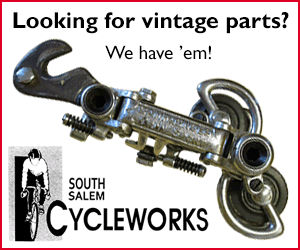Les Woodland Takes His Bike to
Peru and Bolivia
Les Woodland Takes His Bike to
Peru and Bolivia
 If anyone has the right to sing Johnny Cash's "I've Been Everywhere", it's cycling writer Les Woodland. I think the only continent he hasn't visited with his bike is Antarctica.
If anyone has the right to sing Johnny Cash's "I've Been Everywhere", it's cycling writer Les Woodland. I think the only continent he hasn't visited with his bike is Antarctica.
If you enjoy this piece, I know you'll love his book about his trip by bike across the U.S., "Sticky Buns Across America: Back-roads biking from sea to shining sea". Just click on the cover art to the right to get your print or Kindle copy.
They're crafty, those English! The Spanish went to Bolivia to dominate the locals, rob them and put them to work. And, as it happens, make them speak Spanish.
And the English? They were a lot more crafty. They went there a century later to sell them… bowler hats. Yep, you've got that right. The English arrived with a boatload of the hats that every self-respecting gentleman wore in the City in those days.
Nobody wanted them. Least of all the men. And so the English thought a but and then they tried a different approach. "Ladies," they said, "did you know that these hats could be excellent for your fertility?"

Obviously a married lady...
And the gamble worked. Even today, Bolivian women wear a bowler hat. But only the married ones. It would be too scandalous to wear one if you were still single, you understand…
And how would I know that? Because we've just spent three weeks in the mountains of Peru and Bolivia. And there are no end of mountains. It's all mountains and nothing but mountains. They were never less than 3,700 meters high, at any rate where we were, and in a disagreeable way they sometimes reared as high as 4,300.

We went up in the mountains. Here, on the road from Cuzco to Pisac, Peru
On a bike, it wasn't too hard. An experienced cycle-tourist knows how to stay "under the pedal", as we say in French. But, for me, daily life was harder. I was never ill but, equally, I never felt wholly right either. Steph was sick the first day but, after that, nothing. Me, a man, I suffered. It's not fair, is it?
We went to Lima and naturally everybody (outside Peru) told us it was the most dangerous town in South America. Which didn't deter us from taking a collectivo, one of those tiny communal buses with rather less space then there are passengers.
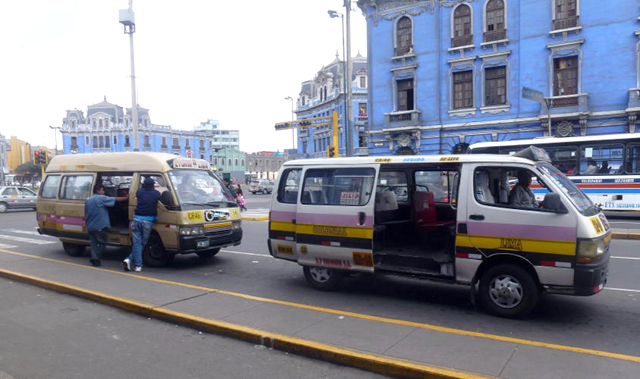
Lima Collectivos
We had no idea of the fare. We offered a handful of coins. The driver smiled… and took the smallest. And then he gave us change. Collectivos, clearly, aren't expensive.
In the bus there was a boy of perhaps 10. He wore a blue jacket with the badge of his school. He looked as though he hadn't long been to a barber's. He looked embarrassed. His mother was proud. We didn't know why but later, at the doors of the cathedral in the centre of Lima, we found several hundred others dressed exactly like him, and young girls in white, and a religious ark, and a cloud of incense, and a dozen musicians who made us think more of New Orleans than a religious ceremony.
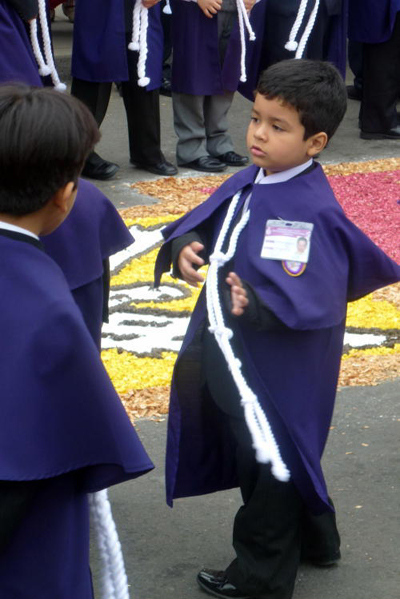
Lima schoolboy
It was our first South American mystery. I speak precisely enough Spanish to order a beer. Which is rarely useful on the steps of a cathedral. So we found a woman who could speak French. She explained, and even now I'm not sure we understood, that it was a celebration of Lima's patron saint. And that's all we grasped.
On a bike, it was less complicated. The climbs were often long but rarely difficult. The countryside was breath-taking in its beauty. Drivers were mystified rather than aggressive, even if they sounded their horn (it's the law, it seems) before and often while they overtook.
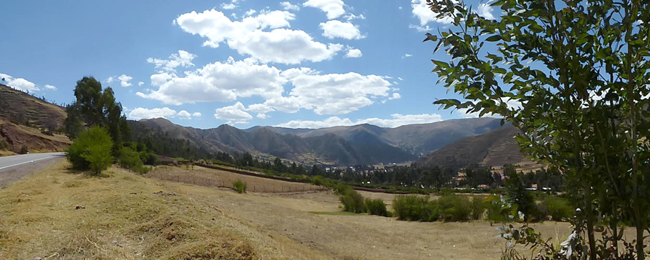
The countryside was glorious
Hard to translate the countryside. Where does everyone live? Where are they going, these old men without teeth who walk slowly with their donkey and wave to us with a hand wrinkled by hard toil? What age are they, these country folk? Hard to say. Peru and Bolivia have a fairly young population, consequence and even a celebration, we gather, of the disappearance of the colonels and their dictatorship.
But there are plenty of adults, too. But of what age? They're maybe only 40 but they're already exhausted, bent.
The Incas are everywhere. Or, more exactly, they used to be everywhere. Neither country lacks the remains of their original population, massacred or reduced to slavery by the conquistadores. The most famous site is Machu Pichu. You don't go to Peru without visiting Machu Pichu, an Inca village that the Spaniards never found.
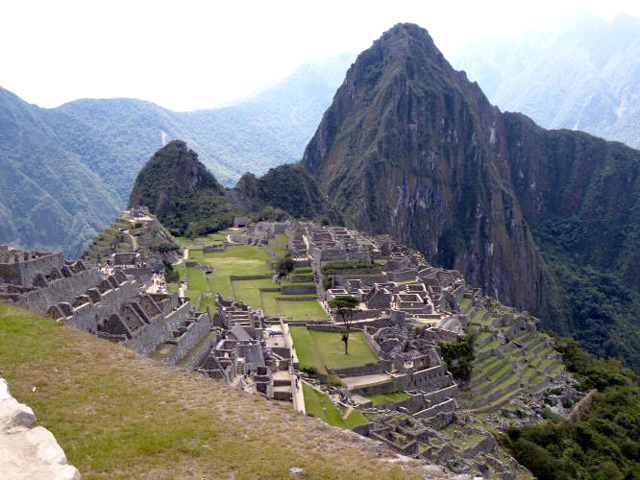
Machu Pichu
It's stuffed with tourists, naturally, but that's what we are, tourists, and so it's an obligation.
We crossed from Peru to Bolivia on a minor road. The Peruvians took the visa we were given two weeks earlier when we arrived. A smile, a farewell. Then a visit to a second office for our exit stamp.
"Haste luego, Peru, y gracias," I said. I like to impress people with my mastery of all the world's languages.
The man, in his brown uniform adorned with insignia, smiled back.
"Si, señor... hasta la vista."
The welcome is just as cordial in Bolivia a few hundred meters late.
"Ah, Francia!" the border guardian said as he looked at my passport. "Tour de France, Tour de France!" He made the universal gesture for cycling, circling his fists in the air. And then he looked at my passport more closely.
"But you're 66!" he said.
I couldn't deny it. I am indeed 66. And I didn't have the Spanish to understand whether he was disappointed that I couldn't ride the Tour de France at 66 or if he was simply impressed that I was still alive.
The road to Copacabana wasn't easy. And Copacabana wasn't pretty, even if it's the town after which the beach in Rio was named. And you want to know now, of course, why and how that came about. But life is full of disappointments and I'm about to add yet one more to yours.
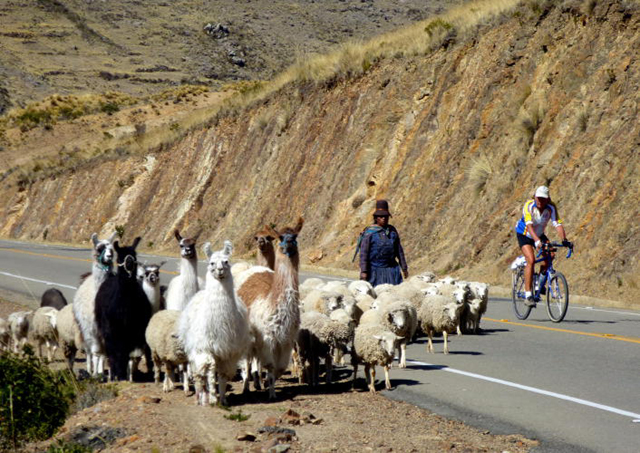
Traffic on the road out of Copacabana
Finally, at the end of a long road noisy with trucks, was La Paz, the capital of Bolivia, hidden in a horseshoe-shaped valley. We were at 4000m, or just a little less. We took a guided tour of the city. Our leader pointed out the national soccer stadium.
"We're in the highest capital in the world," he said, "and so this is the highest national soccer stadium in the world."
And that's not without significance.
"The Argentinian team is the best in the world. When they come to play here, they win. And they run about and they shout with joy and generally they act like Argentinians. But, when they lose, ah, that's another story! They fall to the ground, they grimace and they gasp for breath. They can't breathe any more! Typically Argentines."
And typically me, too. I also grimaced and struggled for breath. But, even so, I was in heaven... at 4000 meters almost literally.
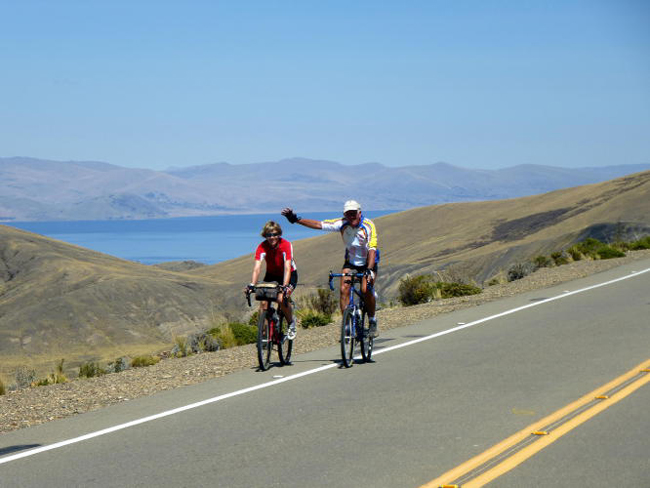
On the roof of the world. Les and Steph Woodland ride at 4,250 meters.




